|
In March 1999, Alex (a friend from Edinburgh now residing in
Manchester) and I flew to Iquitos to take a trip into the Amazon
rainforest. The first time I had been there the previous year it
was a relatively ordinary experience; I stayed in a comfortable
lodge with plenty of facilities and although it was interesting
as an initial experience I didn't see much in the way of
wildlife. This was because the lodge was only about 20km from the
city, the vegetation is secondary growth (the original rain
forest having been cut down), the riverbanks have frequent
settlements and much of the wildlife is scared away (apart from
spiders and insects!) This time I wanted to get well away from
Iquitos and into the virgin rainforest. (Click on the thumbnail
pictures to view them full-size.)
 We flew from Lima and arrived in
Iquitos in the late morning where the temperature was 36 degrees
Celsius, and humid. We were met by our jungle guide called Luis
and planned with him that he would take us 100 km up river for
the following three days. Next morning we were met at the hotel
at 7 a.m. and walked down to the riverbank. We found out our
transport was to be an aluminum; canoe with an outboard motor but
without any protective roof. We loaded up with sleeping
mattresses, food supplies and drinking water, then called at a
floating petrol station to take on fuel. As we headed up-river we
passed the floating shanty town of Belen, the "Venice" of
Iquitos. We flew from Lima and arrived in
Iquitos in the late morning where the temperature was 36 degrees
Celsius, and humid. We were met by our jungle guide called Luis
and planned with him that he would take us 100 km up river for
the following three days. Next morning we were met at the hotel
at 7 a.m. and walked down to the riverbank. We found out our
transport was to be an aluminum; canoe with an outboard motor but
without any protective roof. We loaded up with sleeping
mattresses, food supplies and drinking water, then called at a
floating petrol station to take on fuel. As we headed up-river we
passed the floating shanty town of Belen, the "Venice" of
Iquitos.
At this time of year, towards the end of the rainy season in
the mountains, the river level is nearly at its peak and the
current in the middle of the river is 15 km per hour. So
traveling up-river we stayed close to the riverbank where the
current is less strong. Around Iquitos the river averages 2km
wide and sometimes we had to cross to the other riverbank to cut
off a corner. When we did that we had to dodge round all the tree
limbs and branches that had been torn off trees in the forest
upstream and that were being swept down river.
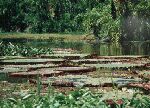 After one hour we stopped at a small
lodge for an hour for some breakfast where we met up with another
couple, an English guy called Richard and his French wife Agnes,
who were to join us on the trip. We then set off again and
continued for a further two hours before turning into the
tributary called Rio Yanayacu. As we got further away from
Iquitos there were less villages and native huts to see.
Sometimes we were able to cut off corners by taking short cuts
through the jungle where the river level was high enough and once
when we did this we saw some Victoria Lilies with leaves nearly
two meters across. After one hour we stopped at a small
lodge for an hour for some breakfast where we met up with another
couple, an English guy called Richard and his French wife Agnes,
who were to join us on the trip. We then set off again and
continued for a further two hours before turning into the
tributary called Rio Yanayacu. As we got further away from
Iquitos there were less villages and native huts to see.
Sometimes we were able to cut off corners by taking short cuts
through the jungle where the river level was high enough and once
when we did this we saw some Victoria Lilies with leaves nearly
two meters across.
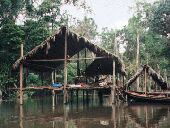 By now the banks of the river
were virgin rain forest and finally in mid-afternoon we arrived
at our accommodation for the next two nights - an open wooden
platform about 3m x 5m on stilts with a thatched palm-leaf roof
and no walls. The river level was 1m below the level of the
platform. At one end of the platform was the kitchen and food
storage area and cooking was being done over a wood fire. There
was just enough room for our sleeping mattresses and mosquito
nets in the remaining space. The other occupants of the platform
were the cook and a young boy who was assistant boatman and
general helper. Non-human occupants were a By now the banks of the river
were virgin rain forest and finally in mid-afternoon we arrived
at our accommodation for the next two nights - an open wooden
platform about 3m x 5m on stilts with a thatched palm-leaf roof
and no walls. The river level was 1m below the level of the
platform. At one end of the platform was the kitchen and food
storage area and cooking was being done over a wood fire. There
was just enough room for our sleeping mattresses and mosquito
nets in the remaining space. The other occupants of the platform
were the cook and a young boy who was assistant boatman and
general helper. Non-human occupants were a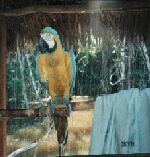 yellow-blue macaw with clipped wings, a
kinkajou that was quite tame and cuddly, and a monkey who was an
absolute pest. After the monkey had stolen some of the food,
broken the glass of the oil lanterns and also a couple of cups,
and got itself tangled in Agnes hair it was banished for the rest
of our stay. The kinkajou being a nocturnal creature slept during
the day (some of the time in my bag) and livened up at night,
although when we bedded down for the night it was taken over to a
tree and deposited there for the rest of the night. yellow-blue macaw with clipped wings, a
kinkajou that was quite tame and cuddly, and a monkey who was an
absolute pest. After the monkey had stolen some of the food,
broken the glass of the oil lanterns and also a couple of cups,
and got itself tangled in Agnes hair it was banished for the rest
of our stay. The kinkajou being a nocturnal creature slept during
the day (some of the time in my bag) and livened up at night,
although when we bedded down for the night it was taken over to a
tree and deposited there for the rest of the night.
There were no toilet facilities on the platform and when we
enquired about this we were directed to a small hut up in a tree
about 30m away with a ladder leading up to it coming out of the
river. The only access from our platform was by canoe through the
jungle. We could ask the boatboy to paddle us across by day but
at night it was self-service. Nobody went during the night. The
men in our group took to relieving themselves from the edge of
the platform into the river. I have really no idea how Agnes
managed. There was a shower next to the little hut but it was
mostly submerged under the water so the only option was to take a
body wash using river water. Nobody bathed for the next three
days.
The first afternoon after a lunch and a siesta we all got
into a wooden canoe and went exploring, with a Luis and the
boatman doing the paddling. After a while we came to an area the
river hadn't inundated and we all got out for a walk through the
jungle. Out guide Luis pointed out the various flora, including a
rubber tree, bromeliads, fungi, and a vine that is a source of
fresh, potable water. (Just cut a section of the vine about half
a meter long and hold it nearly vertical with the bottom end to
your lips and clear, sweet water runs out!) After our walk we
came back to the canoe and disaster struck. I was first to step
in, the bottom of the canoe was wet and slippy, my foot shot out
from under me and I fell backwards into the river. It was only
maybe 20cm deep but enough to get me wet but, worst of all, my
camera that was clipped to my belt took in water. Anyway after
that we carried on and although I was wet I wasn't cold because
the temperature was still around 30 degC.
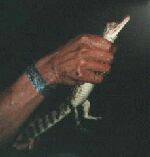 By this time it was dark so we went looking
for cayman (the Amazon alligator). These are also nocturnal,
lying up in reed beds by day and hunting at night. We paddled our
way through the jungle into an oxbow lake and slowly and very
quietly paddled round the reeds. The boatman and guide both had
torches and we saw the eyes of the cayman reflecting back the
light. We must have spotted around twenty altogether. A couple of
times the boatman at the front dipped his hand into the river and
pulled it back out holding a wriggling baby cayman about 40cm
long. By this time it was dark so we went looking
for cayman (the Amazon alligator). These are also nocturnal,
lying up in reed beds by day and hunting at night. We paddled our
way through the jungle into an oxbow lake and slowly and very
quietly paddled round the reeds. The boatman and guide both had
torches and we saw the eyes of the cayman reflecting back the
light. We must have spotted around twenty altogether. A couple of
times the boatman at the front dipped his hand into the river and
pulled it back out holding a wriggling baby cayman about 40cm
long.
After that we went back to our platform where a meal was
being cooked and we were able to have a couple of cans of beer
from the icebox thoughtfully included by our guide in the
supplies we picked up in Iquitos. I also was able to change into
some dry clothing; a task carried out very rapidly as by this
time the hungry mosquitoes had scented fresh blood and were
attacking in mass formation.
After our meal we set out the mattresses, rigged up the
mosquito nets, and since there wasn't much else to do we went to
bed. The jungle is amazingly noisy at night from frogs and other
creatures. Also both at dusk and at dawn we heard howler monkeys
that don't actually howl but make a roaring noise - a really
spine-chilling sound.
Early next morning before breakfast we went out in the canoe
for a paddle around and saw many troops of monkeys and birds of
different species. There were heron, kingfisher, hawks, and many
varieties of parrots, plus many more species of birds that I had
never seen before.
 After breakfast we set off in the
outboard-driven canoe up-river to visit a tribe of Bora Indians
living on a tributary called the Rio Yapara. The journey took
four hours until we came to a group of very simple huts at the
rivers edge. We all thought later that the trip was a bit of a
waste of time as the people didn't have much to show us except
some very simple native handicrafts which they were keen to sell
us. We had some lunch After breakfast we set off in the
outboard-driven canoe up-river to visit a tribe of Bora Indians
living on a tributary called the Rio Yapara. The journey took
four hours until we came to a group of very simple huts at the
rivers edge. We all thought later that the trip was a bit of a
waste of time as the people didn't have much to show us except
some very simple native handicrafts which they were keen to sell
us. We had some lunch there of fried fish and fried
banana which is the staple diet of all the people living on the
river. The journey on the way back was much quicker since we were
going down river, and on the way we saw several pink fresh-water
dolphins in the river. As we were traveling up the Yanayacu near
our campsite some people from a small village on the riverbank
called us over to see a cayman about 3 meters long that they had
snared. there of fried fish and fried
banana which is the staple diet of all the people living on the
river. The journey on the way back was much quicker since we were
going down river, and on the way we saw several pink fresh-water
dolphins in the river. As we were traveling up the Yanayacu near
our campsite some people from a small village on the riverbank
called us over to see a cayman about 3 meters long that they had
snared.
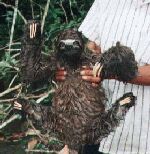 After we got back to our platform and
while waiting for dinner to be cooked we went out in the other
canoe (paddle power again) and saw more monkeys and birds. We
also spotted a sloth about 10 meters up a tree so we paddled to
the base of the tree; our young boat boy climbed up the tree and
tipped the sloth off its perch into the river. Luis then pulled
the wet, bedraggled creature out of the water for us to have a
close look at. It looked really unhappy (well wouldn't you be?!)
so Luis put it back on a branch and as we left the sloth was
climbing back up to resume its siesta. After we got back to our platform and
while waiting for dinner to be cooked we went out in the other
canoe (paddle power again) and saw more monkeys and birds. We
also spotted a sloth about 10 meters up a tree so we paddled to
the base of the tree; our young boat boy climbed up the tree and
tipped the sloth off its perch into the river. Luis then pulled
the wet, bedraggled creature out of the water for us to have a
close look at. It looked really unhappy (well wouldn't you be?!)
so Luis put it back on a branch and as we left the sloth was
climbing back up to resume its siesta.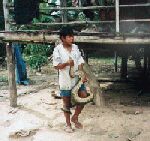
The next night was the same as the first although we all
slept better having got used to the jungle sounds more.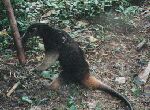 We set off back towards Iquitos
next morning after breakfast and as we passed the same village as
yesterday they called us over again. This time they produced a
large sack and pulled out an anaconda around 3 - 4 meters long
(about half-size!). Richard was brave enough to hang it round his
neck with the help of one of the villagers, We set off back towards Iquitos
next morning after breakfast and as we passed the same village as
yesterday they called us over again. This time they produced a
large sack and pulled out an anaconda around 3 - 4 meters long
(about half-size!). Richard was brave enough to hang it round his
neck with the help of one of the villagers,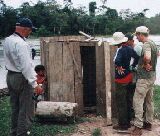 but it was all I could do just to bring
myself to stroke it. The children of the village were tormenting
an anteater that had been foolish enough to stray into the
village. The cayman of last night had been killed and cut up and
was now gently stewing in a large cauldron over a wood fire. (On
return to Iquitos I tried cayman steak in a restaurant and found
it quite enjoyable.) While we were in the village we were also
shown the "prison", a tiny wood hut where a miscreant (usually
drunk on the local home-brew) would be held. but it was all I could do just to bring
myself to stroke it. The children of the village were tormenting
an anteater that had been foolish enough to stray into the
village. The cayman of last night had been killed and cut up and
was now gently stewing in a large cauldron over a wood fire. (On
return to Iquitos I tried cayman steak in a restaurant and found
it quite enjoyable.) While we were in the village we were also
shown the "prison", a tiny wood hut where a miscreant (usually
drunk on the local home-brew) would be held.
The journey back, again being down river, was a lot quicker,
we stopped once for lunch, and again for fuel at a village with a
river-bus station and got back into Iquitos around 4 p.m. We were
really fortunate with the weather during the three days because,
apart from a brief shower during the second night, the only time
it rained when we had to get out our rain ponchos was in the last
half-hour of the return journey.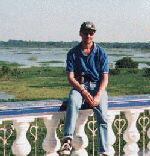 On our return to Iquitos we were able
to shower and shave at last, and have a nice cold beer sat at a
cafe on the Malecon (promenade) watching the Amazon flow by. On our return to Iquitos we were able
to shower and shave at last, and have a nice cold beer sat at a
cafe on the Malecon (promenade) watching the Amazon flow by.
My thanks go to Alex for supplying the pictures. During my
ducking in the river my camera took in water and didn't dry out
fully until I returned to Lima. The few pictures I had already
taken came out fine and the camera is now working as well as
ever.
Now carry on travelling to -
or go  to the Home page. to the Home page.
|











